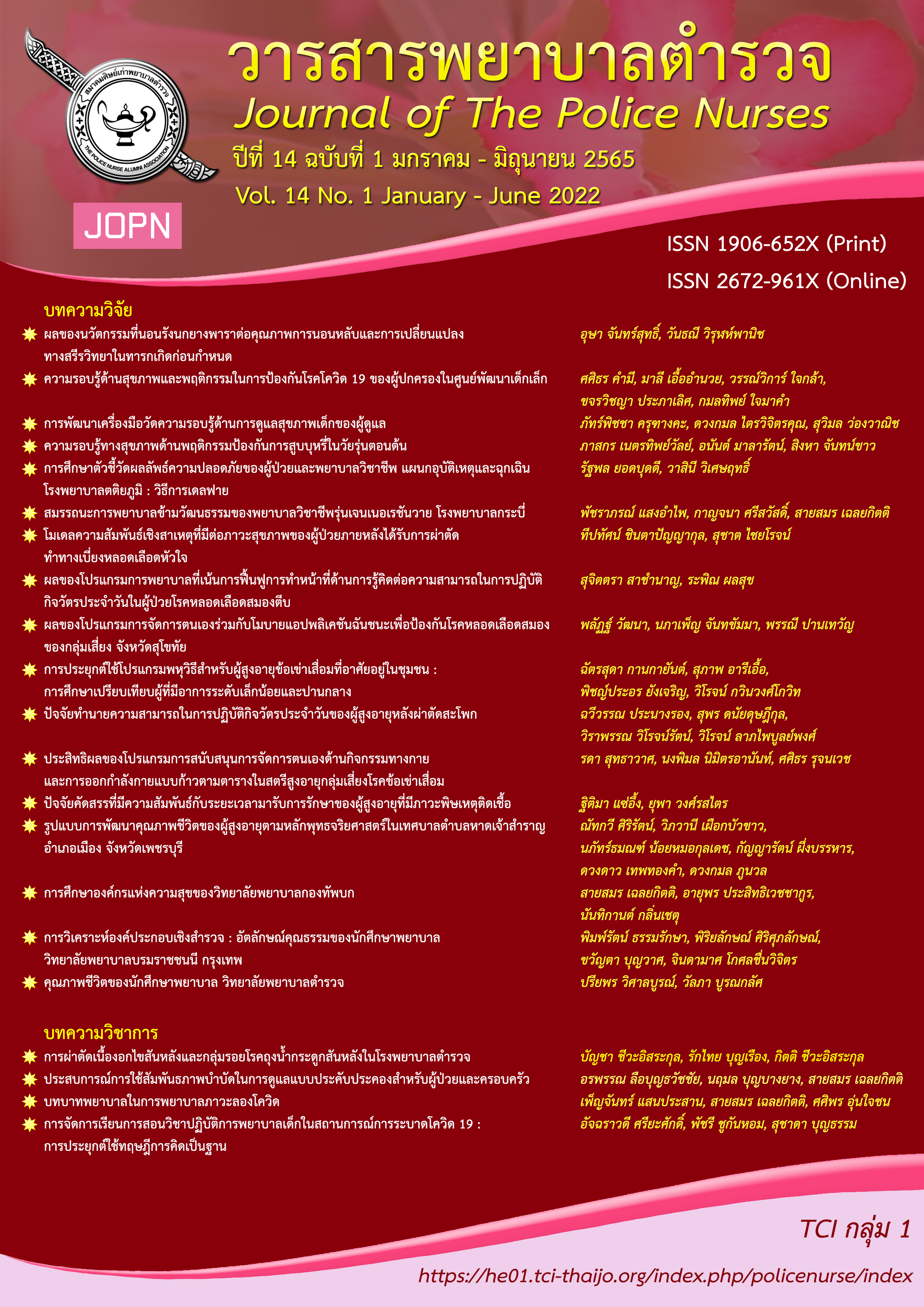โมเดลความสัมพันธ์เชิงสาเหตุที่มีต่อภาวะสุขภาพของผู้ป่วยภายหลังได้รับการผ่าตัดทำทางเบี่ยงหลอดเลือดหัวใจ
คำสำคัญ:
การผ่าตัดทำทางเบี่ยงหลอดเลือดหัวใจ, ภาวะสุขภาพ, การวิเคราะห์โมเดลมิมิคบทคัดย่อ
การวิจัยครั้งนี้มีวัตถุประสงค์เพื่อศึกษาความสัมพันธ์เชิงสาเหตุที่มีต่อภาวะสุขภาพของผู้ป่วยภายหลังได้รับการผ่าตัดทำทางเบี่ยงหลอดเลือดหัวใจ ตัวอย่างคือ ผู้ป่วยที่ได้รับการผ่าตัดทำทางเบี่ยงหลอดเลือดหัวใจที่มารับบริการ ณ แผนกผู้ป่วยนอกศัลยกรรมและหน่วยตรวจพรีเมี่ยม คณะแพทยศาสตร์โรงพยาบาลรามาธิบดี จำนวน 310 คน เครื่องมือที่ใช้ในการวิจัย ประกอบด้วย การประเมินโรคร่วม ความรู้เรื่องโรคและการผ่าตัด พฤติกรรมการดูแลตนเอง และภาวะสุขภาพ ผ่านการตรวจสอบความตรงเชิงเนื้อหาโดยผู้ทรงคุณวุฒิและหาความเที่ยงได้เท่ากับ .93, .87, .79, และ .85 ตามลำดับ วิเคราะห์ข้อมูลโดยใช้สถิติเชิงบรรยาย และวิเคราะห์โมเดลความสัมพันธ์เชิงสาเหตุโดยใช้โปรแกรม Mplus
ผลการวิจัย พบว่า ผู้ป่วยที่ได้รับการผ่าตัดทำทางเบี่ยงหลอดเลือดหัวใจมีภาวะสุขภาพโดยภาพรวมอยู่ในระดับดี โมเดลความสัมพันธ์เชิงสาเหตุที่มีต่อภาวะสุขภาพของผู้ป่วยภายหลังได้รับการผ่าตัดทำทางเบี่ยงหลอดเลือดหัวใจโดยใช้ทฤษฎีการเปลี่ยนผ่านมีความสอดคล้องกับข้อมูลเชิงประจักษ์ (2 (df = 58, N = 310) = 97.588, p = .0009,
2/df = 1.68, CFI = .985, TLI = .981, RMSEA = .047, SRMR = .042) ตัวแปรทำนายทั้งหมดสามารถร่วมกันอธิบายภาวะสุขภาพของผู้ป่วยภายหลังได้รับการผ่าตัดทำทางเบี่ยงหลอดเลือดหัวใจได้ร้อยละ 81.60 ตัวแปรอายุ โรคร่วม และระดับสมรรถภาพของหัวใจก่อนผ่าตัดมีอิทธิพลเชิงลบต่อภาวะสุขภาพ ในขณะที่ค่าการบีบตัวของหัวใจก่อนผ่าตัด ความรู้เรื่องโรคและการผ่าตัด และพฤติกรรมการดูแลตนเอง มีอิทธิพลเชิงบวกต่อภาวะสุขภาพ
ผลการศึกษาครั้งนี้เป็นประโยชน์ต่อพยาบาลในการส่งเสริมความรู้และปรับพฤติกรรมการดูแลตนเองของผู้ป่วยหลังผ่าตัด และพัฒนาเป็นโปรแกรมหรือแนวทางการดูแลรักษาผู้ป่วยตั้งแต่ก่อนผ่าตัดจนถึงหลังผ่าตัด เพื่อส่งเสริมการฟื้นตัวหลังผ่าตัดและเพิ่มผลลัพธ์ทางภาวะสุขภาพที่ดีได้
Downloads
เอกสารอ้างอิง
Abah, U., Dunne, M., Cook, A., Hoole, S., Brayne, C., Vale, L., & Large, S. (2015). Does quality of life improve in octogenarians following cardiac surgery? A systematic review. BMJ open, 5(4), e006904.
Abu-Omar, Y. & Taggart, D. P. (2014). Coronary artery bypass surgery. Medicine, 42(9), 527-531.
Charlson, M. E., Pompei, P., Ales, K. L., & Mackenzie, C. R. (1987). A new method of classifying prognostic co-morbidity in longitudinal studies: Development and validation. Journal of Chronic Disability, 40(5), 373-383.
Chintapanyakun, T., Ua-Kit, N., & Chaiyaroj, S. (2017). Predicting factors of health status among patients after coronary artery bypass graft surgery. Thai Journal of Cardio-Thoracic Nursing, 28(1), 96-110.
Gjeilo, K. H., Stenseth, R., Wahba, A., Lydersen, S., & Klepstad, P. (2018). Long-term health-related quality of life and survival after cardiac surgery: A prospective study. The Journal of thoracic and cardiovascular surgery, 156(6), 2183–2190.
Greenberg, J. W., Lancaster, T. S., Schuessler, R. B., & Melby, S. J. (2017). Postoperative atrial fibrillation following cardiac surgery: A persistent complication. European Journal of Cardio-Thoracic Surgery, 52(4), 665–672.
Hair, Jr. J.F., Black, W. C., Babin, B. J., & Anderson, R. E. (2010). Multivariate data analysis (7th ed.). New Jersey, NJ: Pearson Prentice Hall.
Hardin, S. R. & Kaplow, R. (2016). Cardiac surgery essentials for critical care nursing (2nd ed.). Sudbury, MA: Jones and Bartlett Publishers.
Head, S. J., Börgermann, J., Osnabrugge, R. L., Kieser, T. M., Falk, V., Taggart, D. P., . . . Kappetein, A. P. (2013). Coronary artery bypass grafting: Part 2-optimizing outcomes and future prospects. European heart journal, 34(37), 2873–2886.
Head, S. J., Kieser, T. M., Falk, V., Huysmans, H. A., & Kappetein, A. P. (2013). Coronary artery bypass grafting: Part 1-the evolution over the first 50 years. European heart journal, 34(37), 2862–2872.
Hillis, L. D., Smith, P. K., Anderson, J. L., Bittl, J. A., Bridges, C. R., Byrne, J. G., . . . Winniford, M. D. (2011). 2011 ACCF/AHA guideline for coronary artery bypass graft surgery: Executive summary: A report of the American College of Cardiology Foundation/ American Heart Association Task Force on Practice Guidelines. Circulation, 124(23), 2610–2642.
Kline, R. B. (2016). Principle and practice of structural equation modeling (4th ed.). New York, NY: Guilford Press.
Kurfirst, V., Mokráček, A., Krupauerová, M., Canádyová, J., Bulava, A., Pešl, L., & Adámková, V. (2014). Health-related quality of life after cardiac surgery-the effects of age, preoperative conditions and postoperative complications. Journal of Cardiothoracic Surgery, 9, 46.
Leurmarnkul, W., & Meetam, P. (2005). Properties testing of the retranslated SF-36 (Thai version). Thai Journal of Pharmaceutical Sciences, 29(1-2), 69-88.
McDonald, B., van Walraven, C., & McIsaac, D. I. (2020). Predicting 1-year mortality after cardiac surgery complicated by prolonged critical illness: Derivation and validation of a population-based risk model. Journal of Cardiothoracic and Vascular Anesthesia, 34(10), 2628–2637.
Meleis, A.I. (2010). Transitions theory: Middle-range and situation-specific theories in nursing research and practice. New York, NY: Springer.
Peric, V., Jovanovic-Markovic, S., Peric, D., Rasic, D., Novakovic, T., Dejanovic, B., & Borzanovic, M. (2015). Quality of life in patients of different age groups before and after coronary artery bypass surgery. Annals of Thoracic and Cardiovascular Surgery, 21(5), 474–480.
Powell, R., Scott, N. W., Manyande, A., Bruce, J., Vögele, C., Byrne-Davis, L. M., . . . Johnston, M. (2016). Psychological preparation and postoperative outcomes for adults undergoing surgery under general anaesthesia. The Cochrane Database of Systematic Reviews, 5, CD008646.
Rumsfeld, J. S. (2002). Health status and clinical practice: When will they meet? Circulation, 106(1), 5-7.
Schulz, P., Lottman, D. J., Barkmeier, T. L., Zimmerman, L., Barnason, S., & Hertzog, M. (2011). Medications and associated symptoms/ problems after coronary artery bypass surgery. Heart Lung, 40(2), 130-138.
Stephens, R. S., & Whitman, G. J. (2015). Postoperative critical care of the adult cardiac surgical patient: Part I: Routine postoperative care. Critical Care Medicine, 43(7), 1477–1497.
Stephens, R. S., & Whitman, G. J. (2015). Postoperative critical care of the adult cardiac surgical patient: Part II: Procedure-specific considerations, management of complications, and quality improvement. Critical Care Medicine, 43(9), 1995–2014.
Urtritaprasit, K. (2001). The relationship between recovery symptom and functional outcome in Thai CABG patients. Ohaio: Case Western Reserve University.
Ware, J. E. (2000). SF-36 health survey update. Spine, 25(24), 3130-3139.
Ware, J. E., Kosinski, M., & Dewey, J. E. (2003). Version 2 of the SF-36® Health Survey. Lincoln: Quality Metric Incorporated.
ดาวน์โหลด
เผยแพร่แล้ว
รูปแบบการอ้างอิง
ฉบับ
ประเภทบทความ
สัญญาอนุญาต
ลิขสิทธิ์ (c) 2022 วารสารพยาบาลตำรวจ

อนุญาตภายใต้เงื่อนไข Creative Commons Attribution-NonCommercial-NoDerivatives 4.0 International License.
ผลงานที่ได้ตีพิมพ์แล้วจะเป็นลิขสิทธิ์ของวารสารพยาบาลตำรวจ















